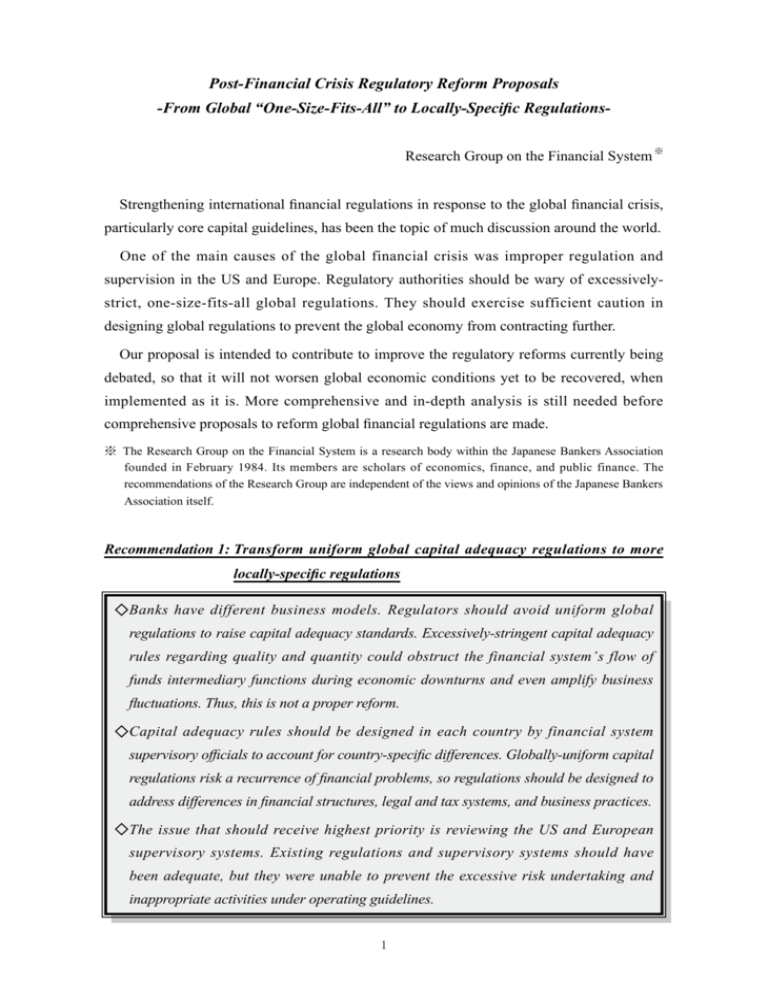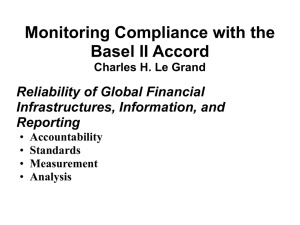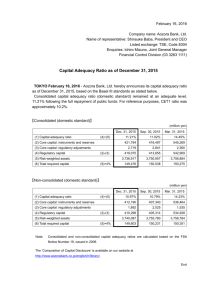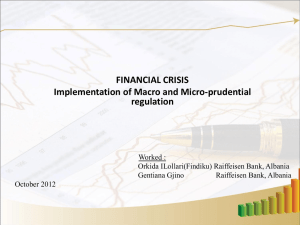Post-Financial Crisis Regulatory Reform Proposals
advertisement

Post-Financial Crisis Regulatory Reform Proposals -From Global “One-Size-Fits-All” to Locally-Specific RegulationsResearch Group on the Financial System ※ Strengthening international financial regulations in response to the global financial crisis, particularly core capital guidelines, has been the topic of much discussion around the world. One of the main causes of the global financial crisis was improper regulation and supervision in the US and Europe. Regulatory authorities should be wary of excessivelystrict, one-size-fits-all global regulations. They should exercise sufficient caution in designing global regulations to prevent the global economy from contracting further. Our proposal is intended to contribute to improve the regulatory reforms currently being debated, so that it will not worsen global economic conditions yet to be recovered, when implemented as it is. More comprehensive and in-depth analysis is still needed before comprehensive proposals to reform global financial regulations are made. ※ The Research Group on the Financial System is a research body within the Japanese Bankers Association founded in February 1984. Its members are scholars of economics, finance, and public finance. The recommendations of the Research Group are independent of the views and opinions of the Japanese Bankers Association itself. Recommendation 1: Transform uniform global capital adequacy regulations to more locally-specific regulations ◇Banks have different business models. Regulators should avoid uniform global regulations to raise capital adequacy standards. Excessively-stringent capital adequacy rules regarding quality and quantity could obstruct the financial system’ s flow of funds intermediary functions during economic downturns and even amplify business fluctuations. Thus, this is not a proper reform. ◇Capital adequacy rules should be designed in each country by financial system supervisory officials to account for country-specific differences. Globally-uniform capital regulations risk a recurrence of financial problems, so regulations should be designed to address differences in financial structures, legal and tax systems, and business practices. ◇The issue that should receive highest priority is reviewing the US and European supervisory systems. Existing regulations and supervisory systems should have been adequate, but they were unable to prevent the excessive risk undertaking and inappropriate activities under operating guidelines. 1 ○ International discussion regarding regulatory reform generally supports tightening current global capital adequacy ratios both qualitatively and quantitatively in order to prevent a recurrence of financial crisis. However, we feel that stricter and globallyuniform capital adequacy rules will have undesirable effects as described below. 1) In retrospect, the current globally-uniform rules have resulted in unintended turmoil in financial systems in various countries. These results included the excessive growth of off-balance sheet activities in the US and the prolonged recession in Japan in the 1990s as bank credit contracted. The results were due to differences in financial system structures among different countries. 2) Banks fulfill an important intermediary function to provide needed funds by supporting firms and individuals. Excessively-strict capital adequacy rules would impair banks’ capacity for financial intermediation and reduce the supply of funds to the economy. 3) Stricter capital rules are likely to aggravate the pro-cyclicality problem. 4) Capital adequacy rules over the last twenty years have been an incentive to international banks to seek higher profits through off-balance sheet activities, rather than to raise capital and reduce risk assets, as the rules originally intended. Banks have transferred risk outside of the banking system, to the shadow banking system. Stricter capital rules could be carefully reviewed in light of the fact that one of the main causes of the financial crisis was the capital adequacy rules. 5) Pushing for higher capital adequacy ratios and bolstering the size and quality of core capital would increase capital for investment bank business models with big trading accounts. But, the high capital cost of core capital could hurt operational soundness, because banks would shift to businesses with higher expected rates of return. This could once again result in excessive risk being taken. On the contrary, commercial banks that focus on deposits and lending would not seek high returns by taking on high risk, and thus would pursue low-risk practices in order to sustain high capital adequacy ratios. Concern could grow about a credit contraction. ○ The global financial crisis revealed that capital adequacy rules, the key bank means for maintaining bank soundness over the last two decades, had become obsolete because of innovations in financial products. It would be unrealistic to expect that tightening the quantity and quality requirements of currents capital adequacy framework regulations without an appropriate supervisory system could prevent another financial turmoil. ○ The investment bank business model––extremely high leveraging and excessive risktaking––was a root cause of the current crisis. Banks in Japan and other Asian countries which were not hit by a financial crisis on the same scale as in the US and Europe 2 generally use a commercial banking business model based on deposit taking and lending. Capital adequacy rules should consider differences in business models and the characteristics of financial markets of various countries. International discussions of global regulations should shift to seek to establish flexible capital adequacy rules that allow for regulators in each country to determine details. ○ Current capital adequacy rules (Basel II) are not implemented consistently in all countries. Local regulators exercise some degree of discretion, such as with the definition of Tier II capital. In the US, Basel II itself has not been adopted. Concerning Tier I capital, regulations should be designed to address differences in each country. ○ Factors not directly related to capital adequacy rules––such as behaviors against management disciplines, including excessive risk-taking, and extremely lax reviews of securitized commodity originations––were major causes of the financial crisis. These behaviors have always been contrary to the management principles of financial institutions. Regulators should prioritize overhauling supervisory structures to uncover and deter inappropriate behaviors possible under existing regulations without any immediate regulatory reform. In the US especially, a decentralized and fragmented regulatory regime should be restructured independently from global regulations. ○ Globally-uniform capital adequacy rules have had different impacts due to differences among countries, such as scale and financial structures, legal and tax systems, and business practices. A fundamental cause of the financial crisis in the US was regulatory arbitrage intended to evade the capital adequacy rules. Larger, deregulated markets encouraged securitization. However, in Asia, including Japan, securitization did not develop to the same extent due to the relatively small size of the capital markets and stricter regulations on new financial commodities. In Asia, banks have been less profitable than banks in the US and Europe. This is because of competitive inequalities over the last decade due to differences among financial systems. Conversely, Asian banks suffered smaller losses from the financial crisis. Globally-uniform capital adequacy rules had unintended negative impacts, which eventually led to the global financial crisis. Regulators should construct new, comprehensive regulatory structures that do not depend solely on capital adequacy rules, including other measures. ○ New financial regulations should be designed based upon assumptions that financial institutions inherently engage in regulatory arbitrage. More constructive regulatory reform should clarify consolidation standards for subsidiaries, define parent banks’ responsibilities, enhance disclosure of off-balance sheet activities, and improve regulators’ financial market supervisory and surveillance capabilities. 3 Recommendation 2: Addressing the issue of “Too Big to Fail” ◇Stricter capital regulations would not solve the “Too Big to Fail ” or “Too Interconnected to Fail ” problems; rather, they could aggravate present conditions. ◇Fixing the “Too Big to Fail” issue would require a series of steady regulatory reforms addressing the issues that have recently come to light. For example, some reforms could include: 1) a framework that would allow a failed bank to withdraw from the markets without the entire financial system collapsing; or 2) a regulatory/supervisory system that ensures that a big market share of a financial product is not concentrated into one specific financial institution or that limits the size of that financial institution to a manageable size. ○ International regulatory gatherings have stressed that additional capital requirements are effective in preventing banks from becoming too big or too interconnected. Such regulations, however, would be ineffective, as described below. 1) It is difficult to determine a bank size that is “Too Big to Fail.” Even if a size could be determined, this could again encourage further regulatory arbitrage. 2) Banks are in a unique position to raise their own capital, since they supply funds to investors to buy their own shares. Merely strengthening core capital regulations would allow big banks to grow even bigger and not solve the “Too Big to Fail” issue. Rather, such regulations could result in adverse effects. 4 Recommendation 3: Ensure adequate liquidity standards ◇Regarding adequate liquidity standards, core deposits are more effective for fundraising than market-based methods. Liquidity regulations should consider the scale of stable deposit fundraising. ○ The global financial crisis highlighted the importance of liquidity management, especially market-based fundraising. Liquidity could dry up suddenly when a crisis hits the economy, even for firms with ample liquidity usually. Various bank assets should be evaluated for liquidity appropriately. ○ Bank deposits are a far more stable source of liquidity than the market. Therefore, it is important to balance non-deposit fundraising and deposit fundraising for liquidity regulations for crisis management. Regulations regarding liquidity standards should differ depending on bank deposit ratio, as opposed to the market liquidity ratio in their liquidity. Liquidity regulations should differ for banks with different liquidity procurement business models. At the same time, another important strategy would be to hold highly liquid financial assets (government bonds, etc.); classifying short-term funds by “stickiness” is also effective. The introduction of appropriate liquidity regulations that consider fund procurement methods warrants examination as a system design in line with actual financial system conditions. Macro-prudential policies ◇An appropriate combination of macro-prudential and micro-prudential policies should be considered. Regulators in each country who are responsible to fix the problem in their own country must make continuous efforts independently to ensure the soundness of the financial system without relying on intervention from other countries. ◇The ongoing efforts of international regulators on regulatory reforms to prevent future financial crisis with only globally-uniform regulations should be redirected towards more diversified regulatory rules with higher emphasis on local specificities. ○ Macro-prudential policies are designed to analyze latent risks in the overall financial system and the real economy prior to a financial crisis in order to establish measures to maintain orderly flows of credit and to minimize the negative effects on a country’s economy. 5 ○ More attention has focused on macro-prudential policies because of the current financial crisis. Regulators failed to recognize excessive expansion of credit and leverage in the financial system in the growth phase, focusing too much on micro-prudential policies of supervising individual financial institutions. Micro-prudential policies involve supervising the soundness of individual banks, whereas macro-prudential policies address the financial system as a whole. The objective of macro-prudential policies is to minimize declines (or in some cases, losses) in national income caused by overall financial system instability. ○ Macro-prudential policies are concerned with the mutual interactions between financial institution practices and real economic activities. Such policies monitor asset prices (like real estate prices) and macro-economic indicators (like GDP), and then estimate how financial institution balance sheets and macro-economic indicators will be impacted should a shock occur. Considering counter-cyclical policy effects is very useful. There are not necessarily established policy practices in macro-prudential policies at present, so this should be an area of careful study going forward. Japan, for example, has a number of different supervising means, including an early correction measures system and the Deposit Insurance Corporation. But supervisory authorities in other countries should be responsible for holding comprehensive discussions, including regarding overall implementation of financial and fiscal policies, while bearing in mind the differences in regulatory and trading customs of different countries. ○ In the recent financial crisis, the danger of surging US housing prices had been noted and viewed as a problem for a while, so the possibility of a bubble collapse was not unpredictable. There were also other problems with financial and fiscal policy operations, such as with government over-intervention in the housing market and continued low interest rates following the bursting of the IT bubble. There are limits to how much simply regulations and supervision can prevent a crisis from recurring. Thus, each country should implement policies cautiously and appropriately and ensure regulation and supervision through close interaction and information exchanges with financial and fiscal authorities. ○ That said, macro-prudential policy is ineffective without micro information managed by under regulatory and supervisory authorities. There should be a balance between macroand micro-prudential policies, without a bias either way. Managing and supervising a financial system in a multi-faceted way also requires that authorities have the autonomy to appropriately implement policies and regulations/supervision with regard to that country’s particular conditions. 6 Lessons from Japan’s experience ◇Japan can offer valuable lessons in managing a financial crisis. Regulatory officials around the world are advised to study the experiences of Japan, which are summarized in this proposal. ○ During Japan's financial crisis in the late 1990s, supervisory authorities did not impose excessive capital requirements, but instead encouraged banks to improve their risk controls. These processes included rigorous assessments of assets to determine losses, carving out bank nonperforming loans, and providing capital injections when banks were short of required capitals. Complex problems cannot be addressed with simple measures like imposing higher capital requirements. ○ One of the main causes of the current financial crisis was regulatory failures in the US and Europe. On the other hand, fundamental disruptions did not occur in Asian countries. The US and Europe could learn from Japan’s experiences in dealing with its own financial crisis when designing global regulatory systems. It would not be optimal that regulatory reform proposals developed by countries whose regulatory systems failed may cover financial institutions with different business models in countries that proved to have working regulatory systems. ○ The ongoing international discussion involves proposals for stricter global capital regulations made by countries in which the financial crisis was triggered, and these new rules would cover countries with different business models in healthier financial systems. The current international discussion has taken the wrong direction. 7






